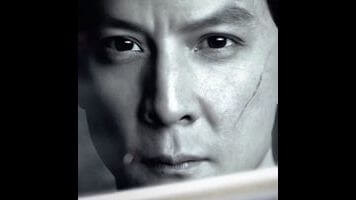Even with winning fight scenes, Into The Badlands can’t kick its way out of a crowded field

Intermittently entertaining but mostly dull and overwrought, Into The Badlands peaks roughly five minutes into the pilot. Over shots of a lone motorcyclist barreling across rose-covered plains, a voice-over explains the series’ premise: Baron-controlled feudal armies made up of lethal fighters (or “Clippers”) rule a land ravaged by war; these armies promise protection to civilians in exchange for their servitude; no one is innocent. Our cyclist, a Clipper, discovers a bunch of executed bodies outside of a charred transport vehicle, but there’s one body clearly missing. In the distance, he sees the group of nomads responsible, finds them, and questions them for the location of the missing person. A beautifully choreographed fight scene ensues with swords, blood, and flesh dancing against each other like a ballet. The cyclist kills them all and discovers a young boy locked in a trunk.
Though this teaser promises a fun, wuxia-inspired samurai series, Into The Badlands takes a more boring, exposition-filled direction almost immediately. The Clipper Sunny (Daniel Wu) takes the young boy M.K. (Aramis Knight) back to his Baron’s fort where series creators’ Alfred Gough and Miles Millar clumsily introduce a whole host of stale characters and broad conflicts. There’s Quinn (Marton Csokas), the ruthless, most powerful Baron in the Badlands, who trains orphans and otherwise abandoned children to become Clippers. Quinn has a power-hungry son named Ryder (Oliver Stark), who wishes to succeed him, but is jealous of his father’s relationship with Sunny. And then there’s Quinn’s first wife, Lydia (Orla Brady), a devoted Lady Macbeth type who wishes that Quinn would be more emotionally available to Ryder. Along the way, Into The Badlands also introduces Veil (Madeline Mantock), a pregnant doctor involved in a secret relationship with Sunny, and another Baron called The Widow (Emily Beecham), who wishes to control the entire Badlands.
It’s not inherently bad that Into The Badlands traffics in genre staples or character archetypes, but it’s that it refuses to liven or deepen them and expects an audience to be emotionally invested anyway. Every time a character speaks it’s either to spout background information that any halfway-attentive viewers would learn on their own or clichéd dialogue that would make even the most hardcore genre fans groan. Into The Badlands’ family squabbles and warring factions are so unspecific that they can’t help but pale in comparison to the myriad other shows (i.e., Game Of Thrones) that take the time to establish similar conflicts in precise, distinctive ways. By the end of the pilot, all these characters and their various desires blend together in a gray blob. Into The Badlands cares about world-building but doesn’t care about the characters that populate the world.
Moreover, Into The Badlands is so jam-packed with these broad character conflicts and relationships—the series also throws in a burgeoning love interest for M.K. in the form of The Widow’s daughter Tilda (Ally Ioannides)—that its emotional core all but falls by the wayside. When Sunny discovers that M.K. harbors dark powers that can only be summoned when he bleeds, he knows there’s a connection between the two of them that goes back to his birth. But Into The Badlands quickly elides their father-son/mentor-mentee relationship in favor of even more tired feudal politics and interpersonal gamesmanship. Sunny and M.K.’s relationship genuinely has some juice, much to the credit of the stoic Wu and not so much the young Knight, who delivers every line in the same forced manner; it’s a shame they keep getting separated in the first two episodes.
But in spite of the series’ poor structural and narrative choices, Into The Badlands’ fight scenes are stellar. Fight director Stephen Fung brings the series its only spark of life with devilish, elaborate sequences of blood and mayhem. When Sunny dispatches some of The Widow’s bandits outside Quinn’s fort, director David Dobkin (Shanghai Knights, Wedding Crashers) shoots the rain-soaked scene with an innate sense of rhythm, treating it more like dance and less like a battle. But it’s Fung and Wu, an active martial artist himself, that elevate the scene to delirious heights. In fact, every fight scene, even the more modest ones, stand out so much because of their direction and choreography. It’s frustrating to have to return to the dull plot when the combat inevitably ends. Though it’s absurd to ask a television series to only be fight sequences, Into The Badlands would be a much better series if it didn’t treat these moments like little pieces of candy within a plate of gruel.
As much as they try, neither the fights nor the occasional stab at poetry—there’s an astonishing shot in the second episode of two pools of blood from the bodies of innocents slowly forming together—can save Into The Badlands from its amateurish storytelling and character details. Of course Sunny has a drug problem that helps him live with his chosen profession. Of course Ryder constantly betrays his father’s trust despite his superficial allegiance to him. Of course almost every female character in the series plays second fiddle to their male counterpart. These are developments that anyone who has paid even slight attention to television in the last decade will find obvious and lame. Though loosely based on the 16th century Chinese tale Journey To The West, Into The Badlands has no interest in folding in its folk mythology into the series that would distinguish it from an overcrowded television landscape. Instead, it adopts a cheap comic-book visual and narrative style that makes it just one in a crowd.